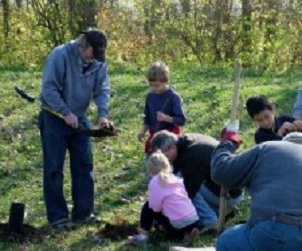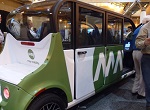Green Communities Address Livability, Climate Change
Last Updated: March 8, 2024
Many cities and towns internationally want to be known as green communities. The benefits of sustainable transportation, renewable energy, recycling, clean water, urban tree cover, and the like certainly help to make a more livable community and help to hold global climate change at bay.
Our experience is that communities can't become green over the course of a year, or maybe even five years, but that slow, steady measures taken toward that goal both make residents feel they are making a positive contribution to the world and give the community a slight edge in the important quest to be a city that can compete well for social and economic progress.
For instance, my little suburb established a sustainability commission. They have led incremental steps toward lowering energy use within the city government and helped keep rooftop solar panels on the public buildings on the agenda. They advocate for EV charging stations, wrestle with getting the county government to stop spraying for mosquitoes indiscriminately, advocate against the garage forward design of homes to the architectural review board, and help residents connect to a rainscaping program for replacing lawn turf with native plantings where appropriate.
Then the restaurant community stepped up with a green dining program. The school district started teaching gardening in the elementary school. Backyard chickens became a bit of a status symbol for households with children in the school system, despite our backyards not being large.
No, one EV charging station in a public parking lot, more gardens than we had 20 years ago, and the elimination of plastic straws won't save the world. As a planner, I would like to see much more aggressive measures to make it safer to walk across our two major streets, decrease our energy usage, and assure that the whole of city government pays attention to sustainability topics, not just one commission. However, these limited measures that we have taken make our younger residents proud to live here and increase their loyalty to the community as a whole.
In short, the process of going green, communities also grow new industries for the local economy, improve public health, create hope for their citizens, and polish their image, which in turns helps to attract new investment.

There is no shortage of quality resources to help your community get started and to gain insight about how to put your own local twist on sustainability.
What stops most cities and towns from joining the trend is that they may perceive that being green or sustainable represents a huge effort, an uphill battle, and a fight not important to the general public. Actually that's a reasonable guess, but it's proving to be incorrect.
In a Western city where we were doing some consulting, there was a loud and sustained public outcry when the city decided to stop its curbside recycling pickup during the early days of the pandemic.
In another case, the local chapter of a national environmental group ran quite a negative campaign when a city government announced it would adopt one new "green" environmental principle per year to emphasize. The environmentalists wanted a much brisker pace. Yet, when we started consulting in that community ten years later, that same environmental group applauded the city's several major accomplishments, including solar installations at every city facility, replacement of the entire stock of street lighting with energy-efficient street lights that are activated only by motion on all but the most important streets, and the planting of well over 1,000 new trees on public and private land.
If your community seems reluctant, point out that some measures taken by green communities can be simple in concept, relatively inexpensive as municipal projects go, and extremely cost effective. For example, in Philadelphia, where the horticultural society had a strong planting program before being green was so stylish, Professor Susan Wachter's research showed that planting trees on vacant lots led to significant appreciation (more than 30 percent) in the value of adjacent lots. Philadelphia Greening has taken the art of planting trees and installing a uniform fence around vacant lots to a new level of neighborhood stabilization.
We find the STAR Communities division of topics, rating guide, certification program, and technical materials to be fairly practical, and we suggest that your city staff or sustainability commission (described below) look over those resources as you start your local work. Their website includes reports from their certified communities. (Approach this and all certification programs with healthy skepticism, but often they motivate local action.) This non-profit organizations represents collaboration among large non-profits, the National League of Cities, and foundations.
Cities internationally join one of the STAR Communities partners, ICLEI Local Governments for Sustainability, and mayors sign the U.S. Conference of Mayors climate protection agreement.
Large cities will want to read the research and think about the methodology behind the Green City Index. The index project seems to have fallen dormant, but some useful studies of cities in Asia, Europe, and Latin America were completed based on the still-valid methdology.
Each of these organizations, certifications, and indexing projects can provide valuable insights, examples, and information.
Sustainability Steps for Local Governments
Besides planting appropriate trees as outlined in our tree canopy page, municipalities can lead as green communities through cleaning up their own house. This often includes:
- Retrofitting government buildings and street lighting for energy efficiency,
- Enforcing a "no idle" policy for city vehicles (and school buses, if under your control),
- Purchasing only natural gas powered, electric, or hybrid vehicles when buying new ones,
- Enhanced recycling efforts in city buildings but also when solid waste services are negotiated if you use private contractors,
- Taking the lead in recycling its own unused buildings into productive uses,
- Giving preference to redevelopment or infill projects in the granting of economic development incentives,
- Prioritizing or giving incentives for developments that reduce the need for residents and employees to drive,
- Doing your utmost to address causes of climate change worldwide, and to address any specific concerns your own community may have about storms, sea level rise, changes in agricultural viability, and tourism through climate change planning,
- Adopting land use policies that specify parking maximums rather than minimums, encourage a dense and walkable core, discourage strip centers, reduce required lot sizes, and encourage creative ways to add housing density while actually enhancing consumer appeal, and
- Adding safe off-street bicycle and walking paths through parks, unused street or utility rights-of-way, vacant lots, commercial or industrial developments (especially if empty), and flood or disaster buy-out land.
- Enlarging the constituency and the stakeholders for public parks and open space beyond simply the parks department and sports participants. Point out the value of parks in creating job opportunities for young people or those without specific job skills, enabling young people to come together to learn leadership skills and civic engagement in an unstructured place like a park, encouraging chance encounters that help to build community, and providing free exercise opportunities to seniors. While these groups may have different motivations for engaging with the parks, enlarged public support for green spaces obviously will help preserve them and the environmental benefits they provide. For more on this topic, see the still timely report on the public value of urban parks.
Green Ordinances and Requirements
In addition, green communities often enact a flurry of green legislation:
- Making it easier to build earth-friendly development forms, such as mixed-use development, transit-oriented development, and cluster housing, also known as a conservation subdivision.
- Requiring density, thereby reducing the need for, and increasing the efficiency of, roads, utilities, and everything linear. (Yes, we know it's controversial; maybe you can use the green communities angle to push through something that would not have been seriously considered before.) In particular there is an opportunity to add considerable density along major streets without impacting single-family subdivision very much. For more on this idea, see our YIMBY page. Also you may need to allow and prioritize the addition of accessory dwelling units (ADUs).
- Requiring or stiffening requirements for a riparian buffer by streams, rivers, creeks, drainage ditches, or whatever you call them. ("Riparian" simply means pertaining to water. "Buffer" is a term for space allowed for transition in uses.) In this case, a riparian buffer would provide vegetation that would filter out pollutants and slow down the stormwater runoff as rain or snow melt enters water bodies.
- Requiring tree preservation or planting for new development.
- Requiring permeable pavement for new parking lots ("permeable" means water can soak into it).
- Requiring low-impact development techniques in parking lots; for example, the tree island between parking rows could be V shaped instead of higher than the parking lot, thus allowing the runoff to flow into the space between the rows and be filtered rather than immediately running off the lot.
- Requiring or providing incentives for solar panels, EV charging stations, native plant landscaping, and development of safe sidewalks and bicycle lanes, as well as off-street trails where possible.
Pausing here for a moment, we see that
these first four legislative measures for green communities fall within
the traditional boundaries for municipal land use regulation. The connections among these measures are explained in a recommended book, Green Metropolis: Why Living Smaller, Living Closer, and Driving Less Are the Keys to Sustainability. As this book points out, many popular and trendy sustainability measures are fairly pointless unless you address root causes and impacts of a scattered development pattern and therefore more driving of personal automobiles.
Other community legislative initiatives could include:
- Requiring or giving incentives for green home construction
- Requiring or encouraging new development to include green roofs, which actually grow vegetation in shallow soil on the top of the roof, or white roofs, which are white or light colored roofs that reflect heat—helpful if you are in a warmer climate
- Encouraging or requiring energy-efficient and water-efficient fixtures and appliances in new construction or significant renovation (probably through adopting an energy conservation code, which can be adopted separately, or through local amendments to a building code and existing building code if you have one).
- Providing municipally sponsored construction material recycling or electronic waste recycling
- Reining in policies that promote sprawl, which results in extra use of energy for transportation
- Addressing particular ways in which climate change might impact your community, whether that is increased risk of flash flooding, sea level rise, more frequent severe storms in general, expanding floodplains, greater use of air conditioning, new challenges for agriculture, need to decrease water use for landscaping, or whatever is appropriate.
Role of the Sustainability Committee in Green Communities
Often municipal governments are slow to implement these green communities measures simply because staff members don't have time to research the solutions.
Let's face it. In some areas, such as renewable energy, the technology is changing quickly and many unproven techniques are out there. So a busy municipal official may put that brochure about natural gas powered vehicles on the stack to be read someday if there's ever time.
As a first positive step, many municipalities are appointing a green citizens' commission or sustainability committee. As we said earlier in this article, the commission might lead the way in stimulating action by the city government itself, residents, school boards, and businesses.
The municipal sustainability committee, whatever it may be called, can help to research some of these things. They can talk with salespeople, contact other municipalities, and even go on field trips to see what others have done. They can set up peer-to-peer conversations so their government officials don't have to feel as though they are taking the recommendations of citizens without any professional input.
Internet research is key to making the job of the sustainability committee bearable. Making lists of what other similar cities or towns have accomplished can be very helpful.
If your city or town decides it wants to be a green community, the investment in an ICLEI or other membership can be worthwhile. It provides a tool for measuring the community's carbon footprint, and with college intern power it can be implemented over a summer. Then of course a few summers later, you can see your progress and get everyone excited again about participating in the green communities movement.
LEED-Neighborhood Development: A Tool to Evaluate How Green an Area Is
Note that LEED, a program of the U.S. Green Building Council and an acronym for Leadership in Energy and Environmental Design, now has developed a certification for neighborhoods or whole developments, rather than the single buildings for which LEED certification of meeting "green" requirements is most noted.
A very helpful source of information for you as a community leader or activist can be found in the downloadable publication A Citizens Guide to LEED for Neighborhood Development.
This publication will stir up ideas for you even if you know in advance that pursuing the LEED-ND certification is too expensive or cumbersome for the project or existing neighborhood you have in mind.
For communities in the U.S., area-wide projects to help residents and organizations become greener is a pleasant challenge, because on this topic municipalities often have been ahead of state governments and definitely ahead of the federal government in grasping a concept and running with it.
In all parts of the world, many activities of community organizations and non-profits could help your city become known as a leader among green communities. Doing so will position your community to retain your talented young people who care deeply about our planet, to respond quickly to grant opportunities, and to be recognized as a thought leader in your region.
Further Reading for Green Communities
Join GOOD COMMUNITY PLUS, which provides you monthly with short features or tips about timely topics for neighborhoods, towns and cities, community organizations, and rural or small town environments. Unsubscribe any time. Give it a try.






